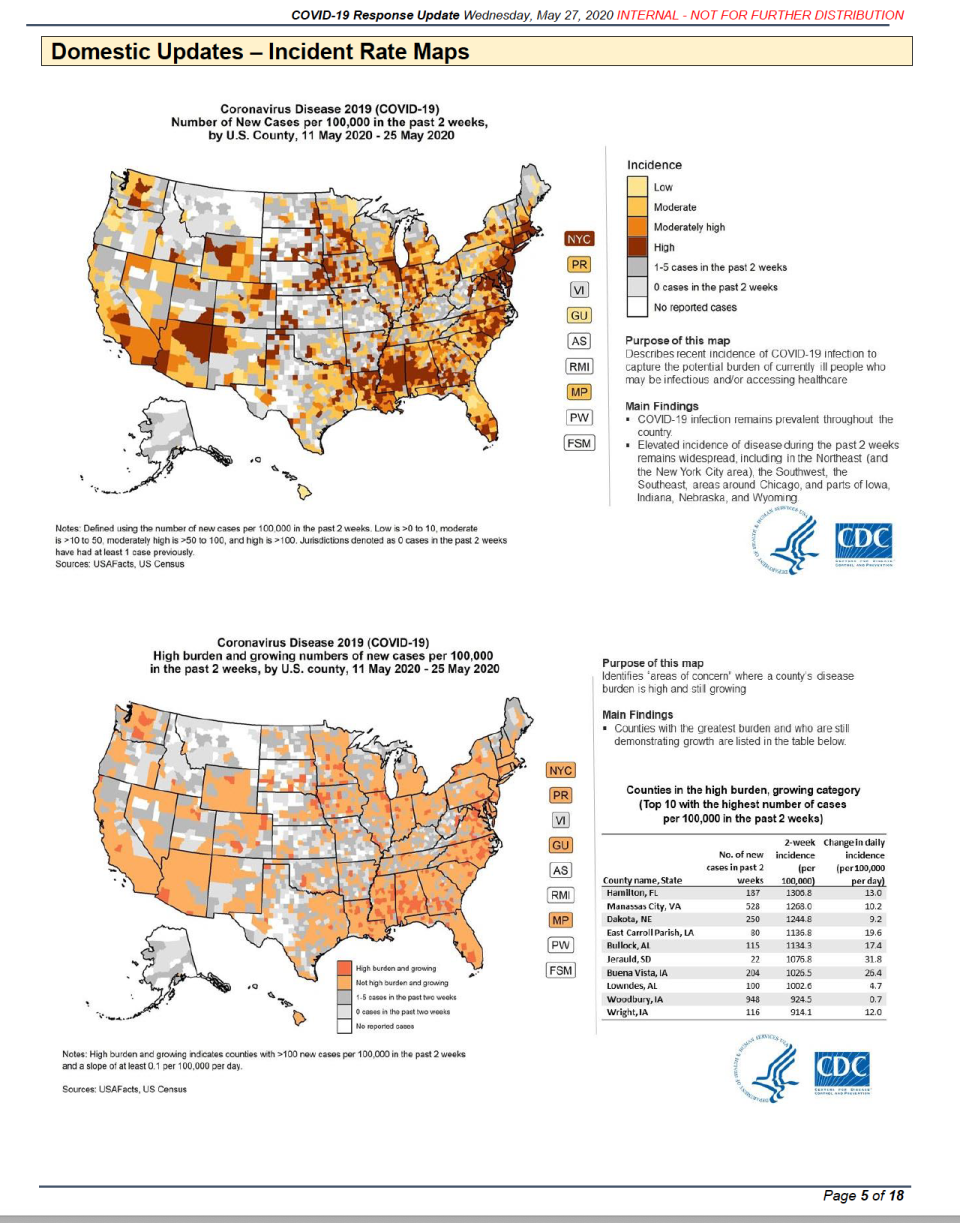Counties in Florida, Iowa worry CDC as emerging coronavirus 'areas of concern'
WASHINGTON — Federal authorities are worried about new coronavirus outbreaks in a number of counties, including in states that have eased lockdown restrictions, like Florida and Alabama, according to a document reviewed by Yahoo News. A list of “areas of concern” also includes persistent hot spots in Midwestern states — including three in Iowa and one each in South Dakota and Nebraska — that are home to major meat processing plants.
The list, which has not otherwise been made public, comes from a document created by the Centers for Disease Control and Prevention and disseminated to other federal agencies.
The CDC ranks the top nine counties and one independent city with rising infection levels. Most of those counties are either in the Midwest or the Southeast, where mostly Republican governors have been quick to reopen their states.
The 18-page document, titled “CDC COVID-19 Response Update May 27, 2020,” contains state-by-state analysis, as well as more detailed county breakdowns. The report comes as the nation enters its fourth full month of battling the disease, which has sickened nearly 2 million Americans and killed 108,000.

The Trump administration promised a “whole-of-government” response to battle the virus, but that has also meant no single agency is responsible for providing statistical updates on progress against the disease. Some governors have criticized Trump for leaving too much to the states, accusing him of abdicating the president’s responsibility to lead.
The CDC’s areas of concern, described as those counties “with the greatest burden who are still demonstrating growth,” are listed according to the number of new cases per 100,000 individuals over the past two weeks, which in this case were the last two weeks of May. In descending order, those are: Hamilton County, Fla.; City of Manassas, Va.; Dakota County, Neb.; East Carroll Parish, La.; Bullock County, Ala.; Jerauld County, S.D.; Buena Vista County, Iowa; Lowndes County, Ala.; Woodbury County, Iowa; Wright County, Iowa.
The CDC declined multiple requests to discuss the document. Nor does it appear to have shared its concerns for those counties with the counties themselves.
Two counties told Yahoo News that they communicated frequently with the CDC but knew nothing about being named areas of concern. (Several other counties did not return requests for comment, or did not say specifically whether the CDC had contacted them on this matter.)
“The City of Manassas has not heard from the CDC,” said Patty Prince, communications manager for the northern Virginia city. It is not clear why the CDC singled out Manassas, as opposed to including all of Prince Willliam County, which has struggled to contain the disease.

Karen Landers, a media representative for the Alabama Department of Public Health, said her agency “has not been contacted by CDC regarding these counties and cannot verify the data” in the document identifying Lowndes and Bullock counties as areas of concern. Landers added that the health department was “aware of increases in cases in a number of counties in Alabama and is taking mitigation strategies.”
Also unclear is how the data is collected and how rigorously it is checked with states. “The CDC website numbers have been reviewed and approved by states,” the internal May 27 document says.
The listing comes amid what appears to be an internal government debate about how to calculate what counties are hot spots, a designation that has been used at times by officials to describe certain areas of the country with a concerning number of coronavirus cases. There is no hard-and-fast hot spot or area-of-concern designation. A May 28 internal document produced by the Department of Homeland Security and reviewed by Yahoo News says the Federal Emergency Management Agency’s “Data and Analysis Operational Task Force is analyzing county hot spot watchlists with three different sources and methodologies to assist White House Task Force efforts to select a single method for calculating hot spots.”
FEMA told Yahoo News that “each approach uses different combinations of total and new case information to determine which areas may have increasing activity. The assessment of multiple approaches helps identify the strengths of each.” A spokesperson for the agency would not divulge specifics of those approaches.
In the case of the 10 areas of concern, there appear to be discrepancies. For example, Hamilton County, Fla., is said to have had 187 new coronavirus cases in the last two weeks of May, which is the period reflected in the area-of-concern designation. But the coronavirus tracker administered by Florida’s Department of Health says that only about 70 new cases were detected during the same period.
Florida has come under scrutiny for the integrity of its coronavirus data. Late last month, Rebekah Jones, the data scientist who created the state’s much-praised dashboard, was fired. She alleged that the dismissal was a result of her refusal to manipulate statistics.
Gov. Ron DeSantis, an acolyte of President Trump, has been accused of downplaying the severity of the pandemic in his state.

It appears that the Hamilton County outbreak is related to the spread of the coronavirus in the Hamilton Correctional Institution. According to the state’s Department of Correction, there have been 207 positive coronavirus cases among both inmates and staff at the prison there.
The virus has spread rapidly inside prisons around the country. Food processing plants, where employees work in close quarters, have also been hit hard. That likely explains why the CDC noted an alarming increase in cases in Jerauld County, S.D., home of a JackLink’s beef jerky plant that state officials have identified as a coronavirus hot spot.
South Dakota health officials did not respond to repeated requests for comment.
Iowa has three counties on the CDC list. All three are home to meat processing plants, which President Trump said in April must remain open throughout the pandemic. “The increases are due, in part, to intentional increased testing efforts in certain areas and an outbreak we announced last week related to an employer that offered a large cohort of employees testing,” said Amy McCoy, a spokeswoman for the state’s health department.
The CDC list was compiled shortly before thousands of protesters gathered around the nation to protest the killing of George Floyd, an unarmed black man, by police officers in Minneapolis. Public health officials now worry that the protests could create coronavirus hot spots of their own.
With additional reporting by Jana Winter.
Cover thumbnail photo: Paul Hennessy/SOPA Images/LightRocket via Getty Images
_____
Click here for the latest coronavirus news and updates. According to experts, people over 60 and those who are immunocompromised continue to be the most at risk. If you have questions, please refer to the CDC’s and WHO’s resource guides.
Read more:



